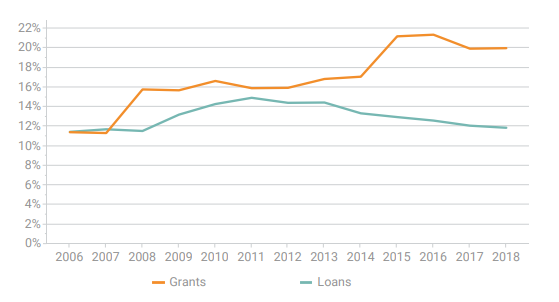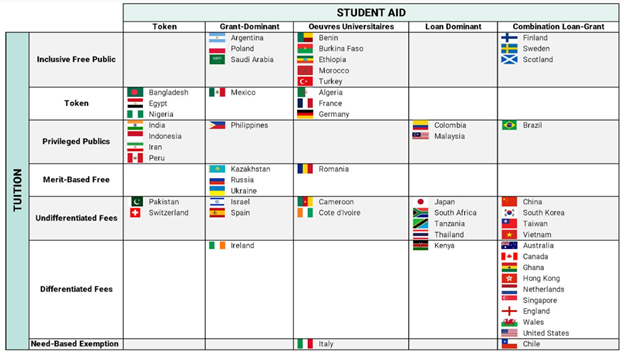By Alex Usher and Jonathan Williams
Last week, we presented you with an overview of tuition fee regimes around the world. Not unreasonably, a few of you asked “what about student aid? Doesn’t that matter?”. Of course it does! And we have you covered.
So first of all, let’s talk about what we mean by student aid. Broadly speaking, it comes in three forms: loans, grants, and “indirect aid”. Loans are simple enough. Grants are trickier, because while they usually come in the form of a cash benefit at the start of a period of studies, they can also appear as “loan forgiveness” (and if we want to get technical about it, we can include tax benefits in this category, but our work mostly ignores them because they are nearly impossible to track correctly outside of Canada).
And then there is indirect aid: which is to say the distribution of non-cash benefits to students, either in the form of subsidized housing, subsidized transportation or subsidized meals. This isn’t all that common globally: it’s essentially restricted to some parts of Europe (France & Germany are the largest examples, though there are others), Turkey and francophone Africa. But where it does occur, it can be incredibly costly to governments, even though transparency with respect to costs and the number of beneficiaries is often lacking.
Globally, the percentage of students receiving direct student financial aid is fairly low. As Figure 1 shows, only about one in five students worldwide receive a grant, and just under one-in-eight receives a loan. In total, that’s about 42 million students with grants and about 25 million students with loans (and quite a number of students have both, though duplication across the two is effectively impossible to track). Two things to note here: first, much of the growth in grants world-wide is due to a policy-shift in China which saw grant recipients there rise from nearly zero in 2006 to 15 million in 2018. And second: the percentage of students receiving loans decreased steadily between 2011 and 2018, which is something very few observers of global higher education would have predicted in 2010.

Broadly speaking, you can classify student aid regimes into five categories. The first is what we’ll call “token” financial aid: that is, a system in which less than 10% of the student population receives any form of aid. There are a lot of big countries where this true – in particular Nigeria, Bangladesh and Pakistan. Then there are “grant-dominant” and “loan-dominant” systems, which are pretty self-explanatory (our cut-off for these is that at least 10% of the student population must receive that form of aid to qualify), as well as “combination” systems, where over 10% of students are in receipt of both loans and grants. And then there is a fifth category, made up of countries which have a substantial grant program and which also provide lots of the “indirect aid” described above: these can be called “Oeuvres Universitaires” systems, after the French term for this kind of arrangement.
Below is a map which shows how these various student aid regimes are spread around the globe (I know it’s small but you can click and enlarge).

Now, some of you will want to know – what’s the overlay between the countries in this map and in the one we published last week? Well, not as big as you’d think. As the table below shows, the seven different tuition fee regimes and the five different student aid regimes actually don’t line up especially neatly. Certainly, there are a couple of significant clusters: the most notable of which are the grouping of Anglophone/Commonwealth countries that combine differentiated tuition fee systems with “combination” student aid systems, and the grouping of African/Middle Eastern countries with a mix of inclusive free public education and an “Oeuvres Universitaires” system. But what is perhaps most remarkable about the table is how spread-out countries are and how few empty cells there are: quite simply, there is a lot of diversity when it comes to fees and aid.

Don’t forget to sign up for the launch-day webinar.

 Tweet this post
Tweet this post
